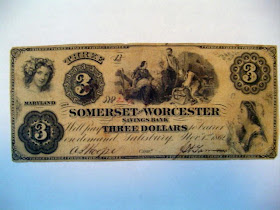 THE SOMERSET AND WORCESTER SAVINGS BANK
THE SOMERSET AND WORCESTER SAVINGS BANKMany banks flourished in the years before the United States government began printing currency in 1862. These were known as “broken banks” and their currency was “discounted” if used out of the area. It is widely collected today. Since the printing was done in the lithograph style, the notes are extremely detailed and beautiful. One of these banks was the Somerset and Worcester Bank in Salisbury, which was in Somerset County at the time. While no mention of the bank’s main office location has been found, the notes are widely found today.
Known history of the bank is that it was chartered on February 27, 1856 and ceased operations about 1863-1864. Black uniface notes were probably the first to have been issued, all recorded copies showing evidence of relatively heavy circulation. Well-circulated copies of both the red and black and the green and black notes are to be found, but uncirculated copies are much more frequently encountered. An opinion has been expressed that the black uniface notes were the last to be issued as the bank officers wished to spend less on the cost of printing by eliminating the colored security prints. It seems more likely that the reverse is the case, the bank officers attempting to increase public confidence in an institution that was in financial difficulty by improving the appearance and security of their notes.
After the bank closed they must have had a supply of the notes on hand as examples of the notes are found with an advertisement overprinted on the reverse from a local business college. These are very rare.
Sets of all four denominations ($1, $2, $3, and $5) of the red and black notes can be formed in which the final digit of the printed 1862 year date has been changed in manuscript, in red ink, to “3”, “4” or “5”. All four denominations of the red and black notes are occasionally found printed on very thin, almost transparent paper, often with an almost oily appearance. The notes were printed by the American Bank Note Co. in New York.

So there was a three dollar bill, not just in the proverbial sense. Very interesting. Thanks George!
ReplyDeleteI just sold one for $100.00
ReplyDeleteInteresting tidbit George!
ReplyDelete